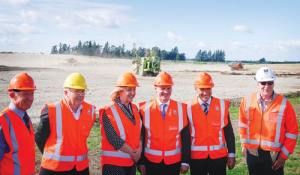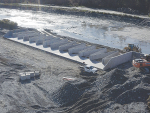Canterbury's Central Plains Water Ltd (CPWL) irrigation scheme has entered stage 2, with Prime Minister Bill English officiating at a ribbon-cutting ceremony at Darfield.
Stage 2 complements stage 1, which takes water from an intake on the Rakaia River near the gorge, and services 23,000ha by way of a 17km open canal terminating near Hororata, with underground laterals to the member farms.
Stage 2 will take water from the end of the existing stage 1 canal to service another 20,000ha of farmland in the northeast half of the CPW area. It will be fully underground, using 2.5m and 2m diameter glass-reinforced plastic pipes – the largest used in New Zealand to date – for the main trunks.
About 220 construction and design staff will be based at Darfield for the duration of the $200 million project, which will be carried out by Downer and is expected to be complete in about a year.
Crown Irrigation Investments Ltd (CIIL) will make a $65 million secured loan to CPW to part-fund stage 2 of the CPW scheme. CIIL invested $6.5 million in CPW stage 1 which has since been fully repaid.
Prime Minister Bill English, who declared the project underway by cutting a red ribbon stretched across a 2m-diameter jointing ring for the glass-reinforced pipe, emphasised both the economic benefits of the scheme and the expected environmental benefits to the stressed waterways of the lower Selwyn Waihora zone.
By bringing in alpine water from the major rivers the scheme is already taking some of the load off groundwater in the stage 1 area. CPWL says it has reduced groundwater take by 75%.
Primary Industries Minister Nathan Guy says the scheme will be a boost to the Canterbury regional economy. A reliable source of water gives farmers certainty and options to invest in mixed farming operations including arable, sheep and beef finishing, dairy farming and horticulture.
“Importantly, it also has many environmental benefits. Using alpine sourced water rather than ground water is environmentally beneficial for Canterbury as it reduces pressure on aquifers which are needed to replenish flows in lowland streams. Replacing groundwater with river and stored alpine river water has the potential to improve water flows into Lake Ellesmere – Te Waihora by an estimated 15-20%, helping the long-term process of improving its water quality,” said Guy.
The day also included a visit to Sheffield, where a 2 million cubic metre storage pond is being constructed for the physically separate Sheffield Water Scheme.
That will service another 4300ha in a northwest corner of the CPWL coverage area, with water taken from the Waimakariri. Under construction by Fulton Hogan, that scheme is due to be operational in October this year.
Meanwhile, Guy also revealed promising results from the Hinds/Hekeao managed aquifer recharge project, a pilot scheme testing the feasibility of using alpine river water to recharge lower aquifers, which he visited earlier in the day.
The project consists of a purpose-built ‘leaky pond’ south of Ashburton, fed with water from the Rangitata River via the Rangitata diversion race and the Valetta Irrigation Scheme, which then drains away to feed the lower aquifers and lowland streams.
“I was pleased to hear that in the first year of this project the bores monitoring groundwater conditions downstream have shown improvements in both water quantity with rising levels and in water quality with decreasing concentrations of nitrates,” said Guy.
Hydrologist Bob Bower, who is leading the MAR project and also attended the Darfield event, said formal results from the first year’s operation were still being collated but confirmed that it was looking good.



















